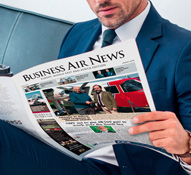 The monthly news publication for aviation professionals.
The monthly news publication for aviation professionals.
A pair of Learjet 35As that joined the AirMed fleet to act as workhorses alongside four Piper Cheyennes have proved their worth during their first year of operation. A five-year period of development for the air ambulance operator has involved the addition of medical equipment, further medical disciplines and expertise, as well as the fleet expansion.
"During 2011 the Learjets flew more than 1,900 hours covering in excess of 660,000 nm," says Jane Topliss, director of business development. "We had always aimed for them to fly a minimum of 800 hours a year each, but it is always reassuring to find them doing above and beyond what we had predicted."
With a better understanding of patient care requirements within the whole insurance industry and with better control of care provision by air ambulance operators, AirMed believes that there is no longer a need for unpressurised piston aircraft to be used for air taxi flights. It has already decommissioned a Piper Seneca aircraft and the remaining Seneca and Piper Chieftain are providing passenger and freight services while they await sale.
Managing director Rupert Dent says: "We can now pool our resources into the best aircraft and make our product delivery better and more cost effective to our clients. With over a third of our transfers requiring a critical care capability, we need to concentrate on ensuring the best possible care provision."
Topliss adds: "AirMed started out using unpressurised piston aircraft more than 25 years ago, providing platforms for assistance company medical crews to perform air taxi transfers. However, as care provision has developed and AirMed's ability to provide that has grown, demand for unpressurised piston aircraft has significantly declined to the point where they will be withdrawn from service."
EURAMI minimum aircraft requirements stipulate a need for a pressurised aircraft, limits on ambient noise and a suitably environmentally controlled cabin. While piston aircraft have been an excellent solution for some transfers, AirMed believes they do not provide an environment that is fully controllable for patient comfort.
"I have received reports from staff who have worked on the unpressurised aircraft that suggest that the lack of comfort for patients leads to increased stress, causing pain and nausea requiring drug and patient care intervention from nursing staff," says Dr Jon Warwick, AirMed's clinical director. "This relates to personal experience with increased use of antiemetics and analgesia on the unpressurised piston aircraft where turbulence would be regularly avoided in other aircraft able to fly at higher altitudes. Increased use of medications to compensate for the aircraft's iatrogenic artefact leads us to our decison. While AirMed has never carried complex patients on its piston aircraft, we believe that moving forward they are not suitable for even the most simple transfers."
The Care Quality Commission in England made it a legal requirement for all England-based air ambulance operators to register with the CQC and within this registration are minimum standards for care provision, treatment, infection control and other areas pertinent to patient transport.
"The legally enforceable standards laid down by the CQC have led to our conclusion that unpressurised piston aircraft provide an environment for patients which would not comply with these standards," says chief flight nurse David Quayle. "Given this, it is difficult to see how any legally compliant English air ambulance operation can operate unpressurised piston aircraft for patient transport."